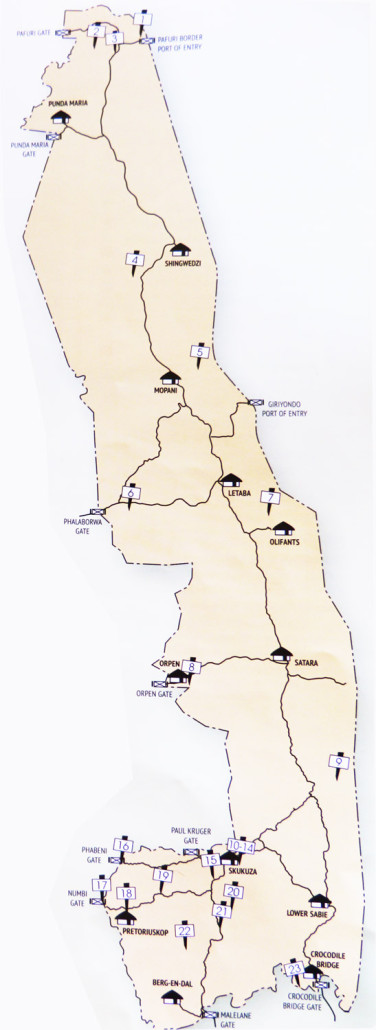Historical Places to see in the Kruger National Park

Indicator of Historical Sites in Kruger National Park
The following Historical Sites are only a few of many more to see in the Kruger National Park, however, these are some of the main ones spread across the length of the Kruger National Park.
1. Crooks Corner
 In the early 20th Century Crooks Corner was used by hunters, ivory smugglers and adventurers to pass through, from one country to another, a small piece of triangular land (where the Luvhuvhu and Limpopo rivers come together) at the South African, Mozambican and Zimbabwean junction. The name says it all as these “Crooks” slipped the borders by using this piece of land. They indeed got away with this as lawmen of all three different countries fought about who would take them into custody.
In the early 20th Century Crooks Corner was used by hunters, ivory smugglers and adventurers to pass through, from one country to another, a small piece of triangular land (where the Luvhuvhu and Limpopo rivers come together) at the South African, Mozambican and Zimbabwean junction. The name says it all as these “Crooks” slipped the borders by using this piece of land. They indeed got away with this as lawmen of all three different countries fought about who would take them into custody.
2. Thulamela
Thulamela is based in the far North region of the Kruger National Park and is a stone walled sighting, dating back approximately 450 years. This late Iron Age site forms part of what the Zimbabwean culture. When Great Zimbabwe was abandoned about 300 years later, several groups moved south across the Limpopo river into the North Eastern areas of South Africa (and Northern Kruger) and established new smaller chiefdoms such as Thulamela Trade was an integral part of life at Thulamela and trade networks extended though the interior of the continent to include Botswana, Zambia, Zimbabwe and Central Africa. At the time that Thulamela was occupied trade on the Indian Ocean was dominated by Muslim Traders which facilitated movement of goods from the Middle East, India, South East Asia and China. Ivory and gold were often traded along the east coast (possibly at Sofala, present day Biera) for glass beads, clothe and glazed ceramics.
3. Baobab Hill
Baobab hill was the final overnight stop between Soekmekaar and Pafuri for goldmine recruits. The large Baobab (seen in the picture) was a landmark on one of the early trade routes. The large Baobab found on the H1-2 between Pafuri and Punda Maria in Northern region of the Kruger National Park. Hunters used this route and it then became known as the “Ivory Trail”. Some of the hunter’s names are also carved onto the tree. Baobab Hill used to be the first “outspan” or camp site (a plaque marks the spot) for migrant workers from the northern areas (what is now Mozambique), who had been recruited to work in the gold mines of the interior.
4. Red Rocks
Red Rocks in Kruger National Park refers to a large sandstone slab exposed by the Shingwedzi River about 15 kms south west of the camp. The latter half of the S52 is a loop road. The Kruger National Park contains rocks that represent the earliest parts of South Africa’s geological history as well as relatively young lithologies. Archaean rocks present in the Kruger National Park include both Archaean granitoid intrusions and Archaean greenstone belt fragments. Archaean granitoid intrusions cover small areas within the western central and western northern parts of the Park.
The rocks of this batholith have an age of 3303± Ma (million years) and mostly consist of coarse-grained porphyritic granodiorites. These rocks are grey to pink and are composed of quartz, plagioclase, microcline and biotite.
Almost the entire eastern half of the Kruger National Park as well as a large area in the western central parts of the Park is underlain by rocks of the Karoo Supergroup and which is overlain by sedimentary rocks from the Clarens formation. Exposure of the Clarens formation is very poor in most areas of the park and is the best seen here at the Red Rocks site.
5. Shilowa Mountains
6. Masorini
A Beautifully restored Stone Age village in Kruger National Park Situated on top of the Masorini Hill, approximately 11km from Phalaborwa entrance gate on the road to Letaba camp. Masorini offers a glimpse of an organized economy that existed before the arrival of European settlers in South Africa.
The village also gives insight into the lifestyle of the Stone Age hunter-gathering society that formed an integral part of the natural environment in Kruger National Park.
Excavations exposed hut floors and artefacts that gave clues to their way of life, homes, iron foundries and commerce. Dome shaped clay furnaces were used to smelt the iron and changed into spears, arrowheads and other tools. These items were traded for glass beads, ivory, animal products and food between the BaPhalaborwa at Masorini, the Venda in the North and later, the Portuguese on the east coast.
7. Von Wielligh’s baobab
G.R Von Wielligh surveyed the the Eastern boundary between Mozambique and South Africa. There is even an historical Baobab tree near the confluence of the Olifants and Letaba Rivers (near Olifant’s Restcamp) in the Kruger National Park, where GR Von Wielligh and company set up their camp number 19. Von Wielligh was one of the original surveyors in the area, and who carved his name on the tree in 1891.
8. Rabelais’ hut
Rabelais’ hut in Kruger National Park. This was originally one of the first entrance gates to the park in the central part of Kruger. The hut is based approximately 9 kilometers from Orpen Rest Camp. The name originates from the original farm it was situated on and the gate was replaced in 1954 and was named Orpen Gate.
9. Harry Wolhuter’s lion attack plaque
10. Skukuza Memorial Library and Museum
11. The Nombolo Mdhluli Conference Centre
12. Little Heroes Acre

Little Heroes Acre is a dogs graveyard situated next to the museum in the Kruger National Park. This graveyard is in memory of these dogs saving numerous lives in warning of danger.
13. Founders of the Kruger National Park

The founders of the Kruger National Park:
Paul Kruger – President of the South African Republic
James Stevenson-Hamilton – First warden of the Sabi Game Reserve
Piet Grobler – Minister of Lands
14. Selati railway line and bridge
The Selati train restaurant and museum is situated in Skukuza Rest Camp. The bridge across the Sabie River was built in 1912. The railway line was build in the early 20th century to help with development in the region and especially to service the sugar industry.
15. De Laporte’s windmill

De Laporte’s Windmill is a typical wind pump used to pump water from boreholes using wind power. CR de Laporte was one of the first rangers in Kruger
16. Albasini Ruins
The remains of the 19th century trading post of the famous Portuguese trader, Joao Albasini is found at the Phabeni Gate, 10 km from Hazyview.
Over the ages, trading activity has taken place in the south-eastern region of Africa. Lourenco Marques, now known as Maputo (Mozambique) would have been the starting point (or endpoint) of many of the ancient trading routes that crisscrossed the countryside. When Albasini arrived in the, then Portuguese occupied, port in the early 1800s, he began setting up his trading business. He set up a network of trading routes that reached the inland as far as the Lowveld and by 1845 he had established a trading post at Magashula’s Kraal (now known as Albasini Ruins). This trading post was conveniently positioned along with two of these ancient trade routes.
17. Jock of the Bushveld plaque/s

Statue of Jock in the town of Barberton, where his owner Sir Percy Fitzpatrick was once editor of the Gold Fields News
This brave dog “Jock” was made famous by his companion, author and entrepreneur Sir Percy Fitz Patrick. Together they overcame so many obstacles and Fitz Patrick’s book tells the story of Jock and their journey together. There are many historic sites to visit about Jock of the Bushveld Route in and outside the Kruger National Park.
18. First Tourist Hut

The first tourist hut was built in 1930 and can still be seen at Pretorius Kop Rest Camp in the Kruger National Park.
19. Wolhuter’s windmill

As described before, Wolhuter was one of the first rangers in Kruger National Park, and his windmill, is another indication of the importance of good supply of water in Kruger Park’s hot climate
20. Stevenson-Hamilton Memorial
Stevenson-Hamilton
The Stevenson-Hamilton Memorial is at Shirimantanga Koppie to the famous warden described earlier in this blog post
21. The old Delagoa-Lydenburg wagon road

Joao Albasini’s wagon at Pretoriuskop
The old Delagoa-Lydenburg wagon road was important to the Boer republics of Transvaal and Orange Free State in the late 19th Century, because it offered a route to the sea at Delagoa Bay (Now Maputo). The British controlled most South African Routes to sea at the time, and fought against the Boers in the South African Anglo-Boer War (1899-1902).
22. Mitomeni Dam
Mitomeni Dam is the first concrete dam in Kruger and was built here across the Mitomeni Creek.
23. San paintings

Most San Paintings are in Caves at the foot of rocky outcrops or hills in the Northern and Southern parts of Kruger Park. The ones at Hippo Pools depict the San’s perception of their relationship with nature.
